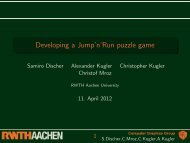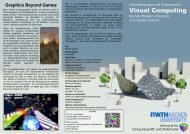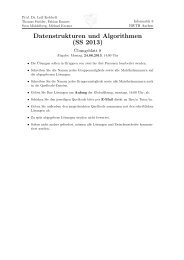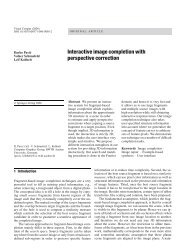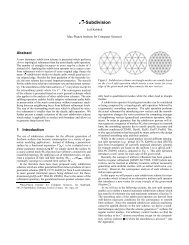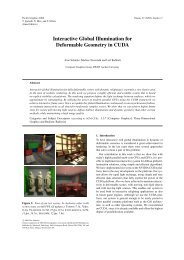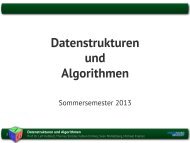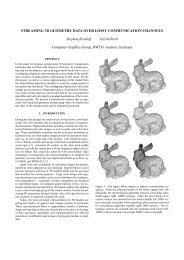Structure Preserving CAD Model Repair - OpenFlipper
Structure Preserving CAD Model Repair - OpenFlipper
Structure Preserving CAD Model Repair - OpenFlipper
Create successful ePaper yourself
Turn your PDF publications into a flip-book with our unique Google optimized e-Paper software.
Stephan Bischoff & Leif Kobbelt / <strong>Structure</strong> <strong>Preserving</strong> <strong>CAD</strong> <strong>Model</strong> <strong>Repair</strong><br />
The position p of the fan’s center vertex is computed by<br />
minimizing the squared distances to the supporting planes of<br />
the triangles that intersect the grid cell [Lin00]. Note that, if<br />
the cell contains a feature edge or corner, this construction<br />
will place p exactly on the feature. If the computed point<br />
p happens to lie outside the cell or if it does not lie on all<br />
supporting planes, it is set to invalid. Invalid vertices are<br />
smoothed in the post-processing stage. Finally we flip the<br />
edges in interior grid faces, such that the center vertices become<br />
connected. This guarantees feature vertices in neighboring<br />
cells to be connected by a (feature) edge (Figure 8).<br />
In both cases we smooth the vertex positions by applying an<br />
iterative smoothing filter [Tau95].<br />
Decimation The output of the reconstruction algorithm is<br />
a closed and manifold triangle mesh T which approximates<br />
the input model M but has all artifacts resolved. However,<br />
T usually contains much more vertices and faces than M 0<br />
due to the artificial refinement near the gaps. This can be<br />
attributed to two effects<br />
• Every patch of the input model is represented from both<br />
sides by T .<br />
• The higher the resolution of the underlying grid, the more<br />
triangles are needed for reconstructing the model in the<br />
critical regions.<br />
Accordingly, we have two options for reducing the output<br />
complexity. First, the mesh T usually consists of multiple<br />
connected components, only few of which really contribute<br />
to the outside of M. The other components merely triangulate<br />
M from the inside and hence can be easily identified<br />
and discarded. The identification can be done manually or<br />
automatically by a flood fill process as in [Ju04]. Second,<br />
we apply a standard feature-sensitive mesh decimation algorithm<br />
to T [GH97]. However, to preserve the input tessellation<br />
of M, we only do this in regions that were reconstructed<br />
anyway.<br />
4. Results<br />
sampled vertex<br />
smoothed vertex<br />
Figure 8: Example configurations (cont.) The geometry in<br />
the critical grid cells is replaced by a reconstructed surface<br />
R which is extracted from the cuts using a variant of the<br />
Marching Cubes algorithm. Some of the vertices of R can<br />
directly be sampled from M. Others, however, correspond<br />
to those parts of R that cover the gaps of M. The position of<br />
these vertices is determined by an iterative smoothing filter.<br />
3.6. Postprocessing<br />
Smoothing After the reconstruction stage the positions of<br />
the following types of vertices is not yet determined.<br />
• Vertices that correspond to those parts of the reconstruction<br />
that span gaps of M and hence have no canonical position.<br />
These are the vertices that either are derived from<br />
cuts (v,d,δ smooth ) or are the centers of triangle fans that<br />
are created in an empty grid cell.<br />
• Vertices that are the centers of triangle fans in grid cells<br />
that contain conflicting geometry — usually due to an insufficient<br />
refinement depth k.<br />
We have evaluated our method on a number of <strong>CAD</strong> models<br />
of different complexities (Figures 9, 10, 11). All timings<br />
were taken on a 2GB, 3.2 GHz Pentium 4 computer.<br />
Choice of input parameters As our algorithm only reconstructs<br />
the regions around artifacts and as this local reconstruction<br />
is further decimated in the postprocessing phase,<br />
the output complexity grows typically only sub-linearly with<br />
respect to the grid resolution. Hence we can use high grid<br />
resolutions to improve the reconstruction quality without incuring<br />
an undue overhead of generated triangles. If the tessellation<br />
of the input patches is sufficiently accurate, we can<br />
set γ = 1 without missing any gaps even for high resolutions.<br />
Asymptotic behaviour If the artifacts form a one dimensional<br />
subspace e.g. along the intersection of two surfaces<br />
or along two abutting patches, the number of critical vertices<br />
and cells should in theory grow linearly with respect to<br />
the grid resolution for a constant γ. Our experimental results<br />
match well with this theoretical statement, only the Camera<br />
model (Figure 10) is an exception because it contains a lot<br />
of interior geometry and “double walls”. These artifacts cannot<br />
suffiently be resolved and hence the critical vertices and<br />
cells actually form a two or three-dimensional subspace. In<br />
these regions the octree has to be refined to maximum depth,<br />
which causes a significant increase in memory usage.<br />
c○ The Eurographics Association and Blackwell Publishing 2005.



